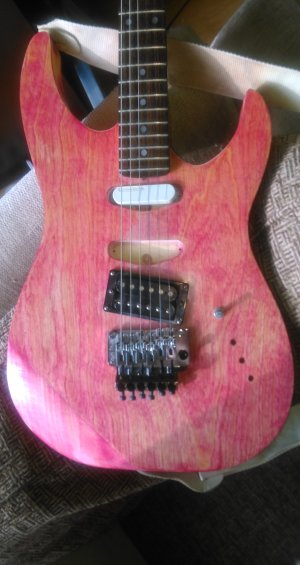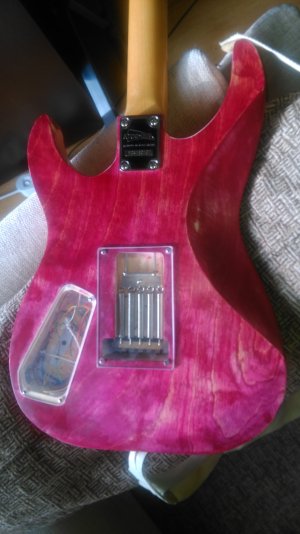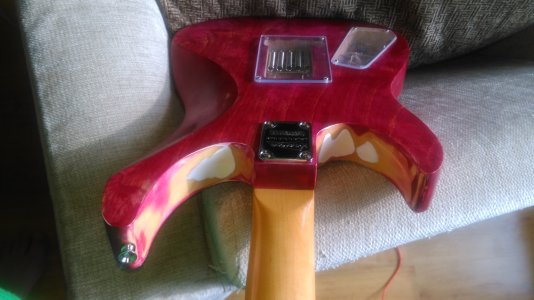I figured since I got an account here, I would share this dye job I did on an old Kramer Focus 6000 I did last year using some reactive dye - the same kind you would use for tie-dyeing natural fiber fabric.
Why did I dye it? A long time ago, I made a "decal" for my guitar using some acrylic gloss and some pics from magazines. they could easily peel on and off, but one day I left some on a white guitar, put it in a case, and forgot about it for a fe months. One day I opened the case, and the acrylic had discolored the paint, through the paint to the primer... oh well. Years go by, I take the guitar apart, sell some parts, then my mom died, who had given me the guitar... so I decided to "resurrect" it back to playing for me and my daughter. We decided to make it "kind of" a relic, but not in the beat sense, just the "imperfect" sense. This "refinish" was NEVER meant to be perfect.
So, I sanded the guitar's body down, past the smell of pingpong balls to the bare wood, except where I didn't want to take off any more, just to show that it was "something else" before. As I sanded, I thought "oh wow! It's a one piece body?!?!"
Not really, the top had a veneer of some sort on it, so I tried not to sand through it. I sanded it until, well, you can see in the pics. It stayed unsanded for more than a year... that's one reason why there are obvious "off" spots, I mean besides just not wanting to go "perfect".
I decided to experiment, and that's where the reactive dye came in. I have big bottles of red, blue and yellow. My daughter wanted a dark pink, and without even trying on a blank piece of wood, we just went to it.
I made a solution of washing soda, to make the reactive salt for the dye, and wiped it on the guitar, let it wet the wood, then left it to dry.
A few days later, I mixed up the dye with some ore soda in it, for extra reactivity, and wiped down the guitar. The top stained pretty even, but the sides and back took in the dye differently, and darker. I wet sanded the dyed wood with some fine auto paper, and added more dye and sanded up to something like 2000, maybe 2400. At this point the guitar was quite moist, even wet... I took some distilled water soaked some old clean t shirts, and wrapped the body for about a half hour, just to try to get any salts out of the wood into the cloths
I resanded the whole thing until it was very smooth, using the very fine auto paper. Then I decided to fill/finish the whole thing with cyanoacrylate, LOTS of cyanoacrylate, then sanded most of it quite smooth, almost like glass - the problem areas that didn't take the dyeing had some trouble with the glue, but it all worked out in the end.
The superglue seemed to make the body wicked resonant. Just knocking on it makes a quite pleasant "dunk dunk" sound.
Again, this was never supposed to be, or even expected to be perfect - that's obvious. I just wanted to post this just to show my experimental experience using reactive dye, basically a generic Procion MX-type dye, on this guitar of unknown wood.
Why did I dye it? A long time ago, I made a "decal" for my guitar using some acrylic gloss and some pics from magazines. they could easily peel on and off, but one day I left some on a white guitar, put it in a case, and forgot about it for a fe months. One day I opened the case, and the acrylic had discolored the paint, through the paint to the primer... oh well. Years go by, I take the guitar apart, sell some parts, then my mom died, who had given me the guitar... so I decided to "resurrect" it back to playing for me and my daughter. We decided to make it "kind of" a relic, but not in the beat sense, just the "imperfect" sense. This "refinish" was NEVER meant to be perfect.
So, I sanded the guitar's body down, past the smell of pingpong balls to the bare wood, except where I didn't want to take off any more, just to show that it was "something else" before. As I sanded, I thought "oh wow! It's a one piece body?!?!"
Not really, the top had a veneer of some sort on it, so I tried not to sand through it. I sanded it until, well, you can see in the pics. It stayed unsanded for more than a year... that's one reason why there are obvious "off" spots, I mean besides just not wanting to go "perfect".
I decided to experiment, and that's where the reactive dye came in. I have big bottles of red, blue and yellow. My daughter wanted a dark pink, and without even trying on a blank piece of wood, we just went to it.
I made a solution of washing soda, to make the reactive salt for the dye, and wiped it on the guitar, let it wet the wood, then left it to dry.
A few days later, I mixed up the dye with some ore soda in it, for extra reactivity, and wiped down the guitar. The top stained pretty even, but the sides and back took in the dye differently, and darker. I wet sanded the dyed wood with some fine auto paper, and added more dye and sanded up to something like 2000, maybe 2400. At this point the guitar was quite moist, even wet... I took some distilled water soaked some old clean t shirts, and wrapped the body for about a half hour, just to try to get any salts out of the wood into the cloths
I resanded the whole thing until it was very smooth, using the very fine auto paper. Then I decided to fill/finish the whole thing with cyanoacrylate, LOTS of cyanoacrylate, then sanded most of it quite smooth, almost like glass - the problem areas that didn't take the dyeing had some trouble with the glue, but it all worked out in the end.
The superglue seemed to make the body wicked resonant. Just knocking on it makes a quite pleasant "dunk dunk" sound.
Again, this was never supposed to be, or even expected to be perfect - that's obvious. I just wanted to post this just to show my experimental experience using reactive dye, basically a generic Procion MX-type dye, on this guitar of unknown wood.





